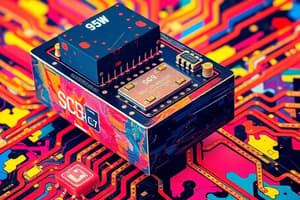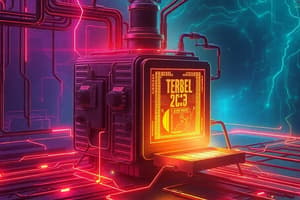Podcast
Questions and Answers
What is the basic structure of a silicon controlled rectifier (SCR)?
What is the basic structure of a silicon controlled rectifier (SCR)?
- A single-layer semiconductor with two terminals
- A two-layer structure of either N-type or P-type semiconductor
- A three-layer structure of alternating silicon and germanium
- A four-layer structure of alternating P-type and N-type materials (correct)
In which mode does an SCR operate when it is off and blocking current in the reverse direction?
In which mode does an SCR operate when it is off and blocking current in the reverse direction?
- Forward Blocking Mode
- Forward Conduction Mode
- Reverse Blocking Mode (correct)
- Latching Mode
Which of the following is NOT an advantage of using SCRs?
Which of the following is NOT an advantage of using SCRs?
- High Power Handling
- Efficient Switching
- Bidirectional Conductivity (correct)
- Thermal Stability
What allows SCRs to be precisely controlled during operation?
What allows SCRs to be precisely controlled during operation?
Which of the following statements best describes the forward conduction mode of an SCR?
Which of the following statements best describes the forward conduction mode of an SCR?
Which application would be most suitable for SCRs due to their characteristics?
Which application would be most suitable for SCRs due to their characteristics?
What is one significant disadvantage of SCRs compared to other semiconductor devices?
What is one significant disadvantage of SCRs compared to other semiconductor devices?
What does the term 'latching' refer to in the context of SCR operation?
What does the term 'latching' refer to in the context of SCR operation?
What is the primary function of an SCR in electronic circuits?
What is the primary function of an SCR in electronic circuits?
What is the consequence of the latching behavior of an SCR?
What is the consequence of the latching behavior of an SCR?
What does the term 'holding current' refer to in SCR operation?
What does the term 'holding current' refer to in SCR operation?
What is a potential drawback of SCRs due to their sensitivity?
What is a potential drawback of SCRs due to their sensitivity?
What differentiates a Shockley diode from an SCR?
What differentiates a Shockley diode from an SCR?
In designing circuits with SCRs, what complicates the process of switching off?
In designing circuits with SCRs, what complicates the process of switching off?
Which term describes the structure of both SCRs and Shockley diodes?
Which term describes the structure of both SCRs and Shockley diodes?
What type of signal is necessary for an SCR to be triggered into conduction?
What type of signal is necessary for an SCR to be triggered into conduction?
What condition must be met for an SCR to turn on after the gate signal is applied?
What condition must be met for an SCR to turn on after the gate signal is applied?
Which of the following is NOT a common application of SCRs?
Which of the following is NOT a common application of SCRs?
How do SCRs enable power control in AC applications?
How do SCRs enable power control in AC applications?
What happens to an SCR when the current falls below the threshold after activation?
What happens to an SCR when the current falls below the threshold after activation?
SCRs are primarily used for controlling power in which type of voltage applications?
SCRs are primarily used for controlling power in which type of voltage applications?
What is the role of the gate in an SCR?
What is the role of the gate in an SCR?
Which of the following devices commonly utilizes SCR technology?
Which of the following devices commonly utilizes SCR technology?
A characteristic feature of SCRs is that they act as a switch that remains off until:
A characteristic feature of SCRs is that they act as a switch that remains off until:
Flashcards are hidden until you start studying
Study Notes
Overview of Silicon Controlled Rectifier (SCR)
- SCR is a unidirectional semiconductor device comprised of silicon, featuring a four-layer alternating structure of P-type and N-type materials.
- It operates as a three-terminal device with terminals labeled anode, cathode, and gate.
- SCR is a trade name for a thyristor introduced by General Electric.
Modes of Operation
- Reverse Blocking Mode (Off State): The SCR blocks current in reverse bias, creating a depletion region.
- Forward Blocking Mode (Off State): The SCR also blocks current in forward bias until a certain threshold is reached.
- Forward Conduction Mode (On State): When triggered by the gate, the SCR conducts current and remains on as long as the current exceeds the holding level.
Advantages of SCR
- High Power Handling: Capable of managing high voltages and currents, ideal for power control applications.
- Efficient Switching: Provides efficient operation with minimal power loss in the on-state.
- Controlled Firing: Can be turned on with a gate signal for precise control.
- Thermal Stability: Operates over a broad temperature range with good thermal characteristics.
- Durability: Robust construction leads to an extended operational lifespan.
- Cost-Effective: Generally lower cost compared to other high-power semiconductor devices.
Disadvantages of SCR
- Unidirectional Conductivity: Conducts current only in one direction, limiting application versatility.
- Triggering Requirement: Needs a gate signal to initiate conduction, adding complexity to control circuits.
- Latching Behavior: Remains conducting until the current falls below the holding level, complicating frequent switching.
- Complexity in Switching Off: Requires current reduction below the holding level or auxiliary circuits for shutdown.
- Sensitive to Overvoltage: Risk of damage if exposed to excessive voltage conditions.
Comparison with Other Semiconductor Devices
- Shockley Diode vs SCR: Both are four-layer devices; the Shockley diode has two terminals and conducts like a regular diode once the threshold voltage is achieved, while the SCR requires a gate signal and remains on as long as there is sufficient current.
- SCR vs SCS: The Silicon Controlled Switch (SCS) has four terminals and allows for better control, enabling turning on and off through the gate and anode gate terminals.
Applications of SCR
- Commonly utilized in high power control devices, particularly in medium- to high-voltage AC power applications.
- Key applications include:
- Speed controls for motors
- Light dimmers for adjustable lighting
- Rectifier circuits for converting AC to DC
- Used in various equipment like AC motors, lighting systems, and welding machines.
Studying That Suits You
Use AI to generate personalized quizzes and flashcards to suit your learning preferences.





